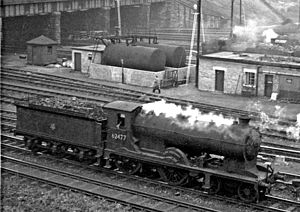NBR K Class
| NBR K class LNER Class D26 / D32 / D33 / D34 |
|||||||||||||||||||||||||||
|---|---|---|---|---|---|---|---|---|---|---|---|---|---|---|---|---|---|---|---|---|---|---|---|---|---|---|---|

62477 Glen Dochart on Eastfield Locomotive Depot, Glasgow, September 1957
|
|||||||||||||||||||||||||||
|
|||||||||||||||||||||||||||
|
|||||||||||||||||||||||||||
|
|||||||||||||||||||||||||||
|
|||||||||||||||||||||||||||
| Type and origin | |
|---|---|
| Power type | Steam |
| Designer | D26, Matthew Holmes D32/D33/D34, William P. Reid |
| Builder | NBR Cowlairs works |
| Build date | 1903–1920 |
| Total produced | 68 |
| Specifications | |
|---|---|
| Configuration: |
|
| • Whyte | 4-4-0 |
| Gauge | 4 ft 8 1⁄2 in (1,435 mm) standard gauge |
| Leading dia. | 3 ft 6 in (1.067 m) |
| Driver dia. | D26, 6 ft 6 in (1.981 m) D32/D33/D34, 6 ft 0 in (1.829 m) |
| Length | D34, 17.068 m (56.00 ft) D26,17.145 m (56.25 ft) |
| Loco weight | D26, 52 long tons (53 t; 58 short tons) D32/1, 53 long tons (54 t; 59 short tons) D32/2, 53.7 long tons (54.6 t) D33, 54.05 long tons (54.92 t; 60.54 short tons) D34, 57.2 long tons (58.1 t; 64.1 short tons) |
| Tender weight | D26/D32, 40 long tons (41 t; 45 short tons) D33, 44.6 long tons (45.3 t) D34, 46.65 long tons (47.40 t) |
| Fuel type | Coal |
| Boiler pressure | D26/D32/1/D33, 190 psi (1.3 MPa) D32/2/D34, 180 psi (1.2 MPa) |
| Cylinders | Two inside |
| Cylinder size | D26/D32/D33, 19 in × 26 in (483 mm × 660 mm) D34, 20 in × 26 in (508 mm × 660 mm) |
| Performance figures | |
|---|---|
| Tractive effort | D26, 19,434 lbf (86.45 kN) D32/1/D33, 21,053 lbf (93.65 kN) D32/2, 19,945 lbf (88.72 kN) D34, 22,100 lbf (98 kN) |
| Career | |
|---|---|
| Operators | NBR » LNER » BR |
| Power class | BR: 3P (except D26) |
| Nicknames | Glen class (D34 only) |
| Disposition | One preserved, remainder scrapped |
The NBR K class is a class of 4-4-0 steam locomotive of the North British Railway. The first batch (later LNER Class D26) was designed by Matthew Holmes in 1902 and had 6-foot-6-inch (1.981 m) driving wheels for express passenger work. Three more batches (later LNER Classes D32, D33, and D34) were designed by William P. Reid with 6-foot-0-inch (1.829 m) driving wheels for mixed traffic work. This included perishable goods, such as fish from Mallaig and Aberdeen. They had inside cylinders and Stephenson valve gear. The D34 locomotives, commonly known as Glen Class, were built with superheaters. The LNER later fitted superheaters to all D26, D32, and D33 engines as well. All engines of the K class are sometimes known as Glen Class, although the designation is strictly reserved to the fourth (D34) batch.
The LNER divided the NBR K class into four classes, as below. It was common practice for the North British Railway to assign similar engines to the same class group, whereas the LNER system allowed only identical engines to bear the same class designation.
Twelve engines ordered in March 1902 and built at Cowlairs railway works in 1903. Three were withdrawn in 1922, leaving nine to enter LNER ownership in 1923. These nine had all been withdrawn by July 1926.
Twelve engines ordered in 1905 and built at Cowlairs in 1906–07. The LNER began to fit superheated boilers in 1923 and classified the superheated locomotives D32/2. The non-superheated locomotives were classified D32/1.
Twelve engines built at Cowlairs in 1909–10. The LNER fitted superheaters to all the D33s between 1925 and 1936.
Ten engines built at Cowlairs in 1913. Twenty-two engines built between 1917 and 1920. All the D34s were built with superheaters. They are known as the Glen Class, as all engines in the group were named after Scottish glens.
The locomotives passed to the London and North Eastern Railway (LNER) in 1923 and, some of them, to British Railways (BR) in 1948. BR numbers were:
...
Wikipedia
